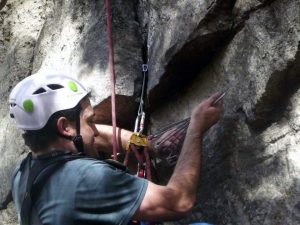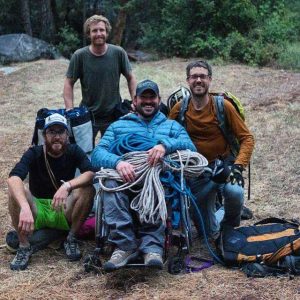El Capitan, the worlds hardest climb, just got more challenging for one adaptive climber
Story by David Barnes
Since 1958 El Capitan in Yosemite Valley has captured people’s attention for big wall climbs and while the experience is extremely popular it is not for the faint in heart.
For Enock Glidden, an ascent of El Capitan is the equivalent of doing 4000 pull-ups. That’s because he is an adaptive climber.
Glidden was born with Myelomeningocele (a form of spina bifida) resulting in a weakened and incomplete spinal column. Glidden is a man who loves being active and believes that his condition has given him opportunities that others may not have had.
He emphasizes to me that Spina Bifida gives him a sense of accepting challenge and tackling it head on. These challenges led him to skiing down mountains and rock
climbing up them.
Difficult and complex climb
Glidden uses a seat and chest harness to keep his center of balance and to keep secured for the roughly 2,000-foot ascent. For comfort and to reduce rubbing, he wears logging chaps that protect his legs and elbow pads for his arms. He has adapted equipment (T-Bar Ascender) that assists him to ascend the rope by pulling up and by which he does not lose any ground in the process.
“My rigging was first used by Mark Wellman who ascended The Nose on El Capitan in 1989 as the first paraplegic,” says Glidden. “Basically, I have a pull up bar built into an ascender that attaches to the rope and another ascender for back up on my harness.”

Glidden was inspired to tackle El Capitan by high school friend, Nick Hall. Hall was a rescue ranger at Mt. Rainier and lost his life in the line of duty. That event just made Glidden even more driven to figure out how to ascend mountains.
It was through an organization called Paradox Sports that Glidden was able to figure it out. This group assists people with disability to become more able with their movement and constructive in their lives.
Just Getting Started
“My first climb was at the Shawangunks,” says Glidden. “I was able to get a feel for the environment and what was possible. I learned about climbing and the equipment that was required.”
Glidden explains that the lights went on inside of his mind and he realized that climbing was a place he could extend himself. “The freedom of leaving my chair behind was enlightening and I loved all the freedom that went with that.”
Wilderness activities for an adaptive athlete are about teamwork. Every time Glidden challenges himself on a cliff or when skiing, there are often others who are partnering with him to ensure he can safely pursue his goals. One of these mentors is, Sean O’Neil, an accomplished adaptive climber.
O’Neil taught Glidden how to climb big walls in his back yard using a tree for practice. He assisted Glidden to dream big and that dream was forged to climb the big stone, the 3,000-foot El Capitan in Yosemite Valley.

It became apparent for Glidden that climbing trees was not enough. He developed repetitive weight training and did a lot of pull ups at his local gym on the East Coast.
In time he built stronger workouts by developing particular muscle groups that would assist him in his climb. Every summer he would get on rock as often as he could pushing his chair through the woods and scrambling on rocks with friends.
Glidden regularly visited climbing crags he could access and began to emerge as a member of the climbing community.
“If I am on the rock face I am like any other climber and others don’t tend to notice my disability,” says Glidden. “If I am in my chair or resting on the ground, they tend to think of me as inspiration. It must be my outstanding looks.”
Climbing Big Walls Evolve
It helps that Glidden enjoys training. Like any athlete he can get into a mood and his training lessons shorten, particularly doing pull ups, but that is often followed by a burst of enthusiasm when he realizes that the goal required work.
Glidden is no stranger to a challenge having completed the Maine Marathon three times and competed in downhill skiing as a team member with Maine Adaptive Sports and Recreation. He has received several gold medals for his performances.
But, he would need all of this experience and training when he found himself at the base of El Capitan. For Glidden this was a pinnacle experience that would require him to find that extra focus that is required to rise above the challenge of a 2,000-foot vertical granite wall.

He did and that saw him in Yosemite Valley where he spent an additional summer climbing famous routes such as Astroman in 2015. The following summer he returned for his big challenge, a climbed named, The Zodiac on El Capitan.
He and his team chose this intimidating climb as it was steep, and this freed Glidden from excessive rubbing on rocks as he would be hanging in space.
Glidden found that when on the climb he would tend to go quiet within himself. If things weren’t going to plan, he would stare at the rope, take a breath and think the problem through. In these moments, Glidden would say to himself, “you can do this. It’s just doing more pull ups.”
Challenges on the wall
“I found that I would drink just enough to stay hydrated,” says Glidden. “It’s very difficult as an adaptive climber to use a bathroom on a multi-day climb.”
Glidden also found it essential to check his skin in all the places he could not feel to avoid any chafing and significant injury.

Appropriate gear was essential. From previous climbs and from his peers Glidden learned that he required superior camping gear that included a sleeping mat that could support his body appropriately and a sleeping bag that could open easily for access and help him sleep more comfortably.
There were a team of climbers accompanying Glidden up El Capitan to assist with the climbing, the hauling, communications and logistics and a team on the ground who would spot the team on their climb.
“I’m grateful for the people who offered these skills to assist in my accent,” says Glidden.
There was a lot of hurry up and wait times on the climb.
“As I was climbing, I was paying close attention to the colors of the rock and the lichen,” says Glidden. “And to my amazement the variety of plants that seem to grow out of the rock.”
After a working week on the cliff Glidden summited El Capitan to well wishes from the team who had assisted him to the base. His climb had obviously struck a chord with the public who had recognized his efforts and the positive significance of his ascent for the adaptive sports community.
Glidden is using this remarkable experience to share with others what can be achieved as an adaptive athlete and as a member of the community. Climbing El Capitan made him realize what he can accomplish. He believes that the first step is to just try.
“When you try, something happens,” says Glidden. “It may not necessarily be what you intended but you will learn something new. The next step is to adapt, take what you’ve learned and tweak it to make it better, like I did with my gear to get up El Capitan. Lastly if you run out of ideas ask for help. Someone in the world has probably done what you are setting out to do and has some valuable knowledge you can benefit from.”
Glidden has learned much in the journey leading up to the climb up El Capitan but in turn his experience and his knowledge is now opening possibilities for other adaptive climbers to try new and exciting climbs. He wants to do the same and is planning to climb of Mt Rainer in 2020.

To follow more of Enock Glidden and his remarkable career as an adaptive climber and as an outdoors athlete check out Gliddenglidden.com.
9 Responses
Great write up Enock dad.
Great story Dave. Enock sounds like an utter legend.
This is so amazing and inspiring. An awesome read thank you for sharing
Inspirational! I looked up Paradoxsport too – do you know if anything like this exists in Oz?
Love ❤️ Winners Never Quit, Quitters Never Win! You are a winner and a true inspiration. Cheers 🥂 and congratulations for breaking down barriers Enock.
Wow – just WOW. The Ability to overcome adversity is the minds capacity to reset pre concieved boundries – love and energy Enock and great tead thanks Dave
Another great read Dave, but a more amazing feat of endurance and fortitude Enock
Super inspiring story. Keep up the great Mojo!!! cheers
Awesole story Dave! Enoch, you are an inspiration. Thank.you for sharing.your amazing.story!